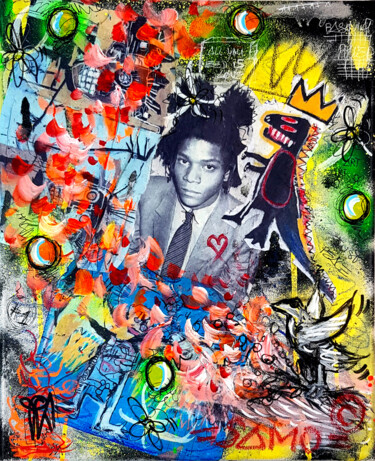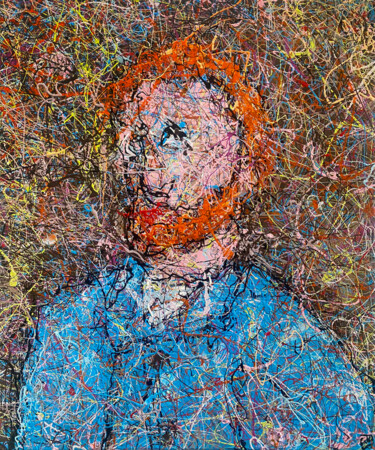14,863 原创艺术品,限量版和版画:
与法国艺术家让·杜布菲 (Jean Dubuffet) 的名字密不可分的艺术运动,原始艺术 (art brut) 继续在当代艺术界取得一定的成功,这从 Artmajeur 艺术家的丰富作品中可以看出。
Art brut 或 outsider art 是法国艺术家让·杜布菲 (Jean Dubuffet) 于 1945 年创造的一个术语,指的是这种特殊的创造性表达形式,主要是自学成才的艺术家、儿童、边缘化人群或精神病患者的作品,旨在实现一种“差异”意识。
事实上,这种特殊类型的艺术家创作的结果是非常不寻常和本能的作品,除了特定的风格或动作之外,这些作品非常原始和情绪化。
局外人艺术的历史是什么?
杜布菲对边缘化艺术的“纯洁性”培养和表现出的高度敏感和强烈钦佩,源于与这位法国大师的基本相遇。
特别是,杜布菲的原始艺术在很大程度上受到了两位著名精神病学家沃尔特·摩根塔勒和汉斯·普林茨霍恩作品的影响,他们对病人的艺术创作着迷,开始重视它并分析、收集和记录它。
恰恰是接触到这些研究的杜布菲完全着迷,以至于相信精神病人的艺术可以代表最纯粹的艺术创作形式。
此外,特别是一本书,普林茨霍恩的 Bildnerei der Geisteskranken,其中分析了欧洲不同机构的精神病患者创作的数千件艺术作品,影响了他的艺术观。
正是在阅读了这部作品之后,杜布菲开始了他的个人收藏,不仅包括精神病患者创作的艺术品,还包括怪人、儿童、格格不入者和流浪者的作品。
这个名为“La Collection de l'Art Brut”的藏品随后由让·杜布菲 (Jean Dubuffet) 捐赠给洛桑市(瑞士),至今仍在开发中。在永久或临时展览的背景下展示的作品旨在鼓励参观者思考和理解这些并非真正艺术家的艺术家。
局外人艺术运动最常用的技巧是什么?
实际上,外来艺术并没有代表技法,因为运动中的每一位艺术家都倾向于自主地表达内心的自我,遵循他们最自然、最简单、最直接、最本能的倾向。事实上,作品可以在多种介质上创作,例如纸张、硬纸板、硬纸板、墙壁、帆布、铜和玻璃。
然而,在这类艺术家的作品中经常会发现某些反复出现的风格特征,例如非常执着和重复的母题和特定的设计方法。
或许,这些接近艺术的方式既揭示了对时间流逝的深刻敏感性,也揭示了在经常有问题和混乱的内部产生一种秩序的愿望。
至于使用的材料,他们和他们的创作者一样,往往是标新立异的,好像他们想更多地连接到创作者丰富的内心世界。
有哪些著名的艺术家和作品?
让·杜布菲 (1901 - 1985)
让·杜布菲 (Jean Dubuffet) 是法国著名画家和雕塑家,被认为是原始艺术 (Art Brut) 艺术运动的创始人。在他的家乡勒阿弗尔的美术学院学习两年后,他于 1918 年前往巴黎,在朱利安学院学习课程,直到六个月后他才离开该机构。 .在这个形成时期,汉斯·普林茨霍恩 (Hans Prinzhorn) 关于疯狂的艺术和原始民族的艺术创作的书对他产生了强烈的影响。然而,他成为画家的决定直到 1942 年才最终确定,在此期间他主要受到表现主义大师保罗克利的影响。但从 1945 年开始,他真正的道路开始了,在此期间,杜布菲理论化并引入了原始艺术的概念。 1947 年,他与 André Breton、Paulhan 和 Drouin 一起创立了“Compagnie de l'art brut”,始终紧跟这一艺术潮流。正是在这些最后的项目中,杜布菲的思想得到了有力的体现:从艺术传统中解脱出来,寻求一种能够为艺术开辟新道路的原创性。
阿道夫·沃尔夫利 (1864 - 1930)
瑞士画家兼原始艺术的主要代表阿道夫·沃尔夫利 (Adolf Wölfli) 在很大程度上以童年时期的不愉快事件为标志,暴力父亲的存在和母亲的早逝对他造成了不可磨灭的打击。这些不愉快的事件,加上这个年轻人在营地工作期间遭受的虐待,导致这个男孩出现严重的行为问题,以至于他先是被监禁,然后,一旦他被证明是精神分裂症状态,就被拘留在Waldau 庇护所(瑞士),他将一直呆在那里直到生命的尽头。正是在精神病院里,艺术家通过绘画自我安慰,逐渐意识到自己的才华,并得到了精神病学家沃尔特·摩根塔勒的大力鼓励和重视。最后,值得强调的是,这位艺术家在他三十年的创作生涯中是如何创作出 1,300 幅画作、几本笔记本和一本印数不少于 25,000 册的巨著传记(圣阿道夫的传奇),这些作品主要是在伯尔尼美术博物馆。
亨利达格 (1892 - 1973)
美国作家和插画家亨利·达格 (Henry Darger) 以他的奇幻手稿而闻名,该手稿名为《虚幻的国度》(The Realms of Unreal),其中用水彩画的局外人艺术的一些最佳范例进行了丰富的插图。关于艺术家的生活,达格在四岁时失去了母亲,与慈爱的父亲一起生活,直到后者年迈残疾被送往养老院。这一集之后,他先是住进了天主教青年收容所,然后又被转移到精神病院,因为他被宣布患有精神病。这种禁闭的痛苦在文学作品《薇薇安的女人》中得到了很大程度的升华。 1908 年,达格设法逃离了精神病院,但他自由的滋味却带有强烈的存在主义的单调感。
霍华德·芬斯特 (1916 - 2001)
美国浸信会艺术家兼牧师霍华德芬斯特声称受到上帝的启发,通过他的艺术创作传播福音,包括局外人、天真和有远见的艺术品。芬斯特的艺术研究在 1980 年代为公众所熟知,当时他为美国著名乐队 REM 和 Talking Heads 设计了专辑封面。就这位艺术家的私生活而言,出生于阿拉巴马州并在他的大家庭农场长大的芬斯特在 13 岁时获得了他的第一个幻觉,这是一个极具启发性的插曲,导致他致力于布道。至于他的艺术生涯,他致力于建造旨在收集和展示人类创造的标本的博物馆,例如植物农场博物馆,以及神圣艺术、肖像和流行文化偶像的制作。
Discover contemporary artworks on Artmajeur
Contemporary art is a vibrant constellation of artistic expressions. This creative universe encompasses a wide array of mediums, from paintings, sculpture, and photography to drawing, printmaking, textile art, and digital art, each medium a star shining with its own distinct radiance. Artists use diverse supports and materials to bring their visions to life, such as canvas, wood, metal, and even innovative digital canvases for the creation of virtual masterpieces.
A contemporary painting, for instance, may weave its story through the masterful strokes of acrylic or oil, while a contemporary sculpture might sing its song in the language of stone, bronze, or found objects. The photographic arts capture and manipulate light to produce striking images, while printmaking employs techniques like lithography and screen-printing to produce multiples of a single, impactful image. Textile art plays with fabrics and fibers, whereas digital art pushes the boundaries of creation with innovative technology.
The allure of contemporary art lies in its boundary-pushing nature, its relentless quest for experimentation and its constant reflection of the evolving human experience. This boundless creativity, coupled with its strong social and personal commentary, makes every piece of contemporary art a unique emblem of its time, a mirror held up to the realities and dreams of our complex world. It whispers to us, moves us, provokes thought, and kindles a deep emotional response, stirring the soul of anyone willing to listen. It is, indeed, the language of emotions and ideas, spoken in the dialect of our era.

©2024 Barbara Versini
Origins and history of contemporary art
The story of contemporary art unfolds in the mid-20th century, marked by seismic shifts in artistic expression. Post-World War II, around the 1950s and 1960s, artists began experimenting beyond traditional confines, challenging the norms of what art could be. This revolutionary epoch birthed myriad new movements and artistic forms such as abstract expressionism, pop art, and minimalism. Paintings, once confined by realism, embraced abstraction, as artists used color and form to express emotions and ideas. Notable periods like the advent of pop art in the late 1950s and early 1960s saw artworks mimicking popular culture and mass media, reflecting society’s shifting focus.
The sculptural arts, too, witnessed a metamorphosis. Sculptors started to experiment with new materials and forms, often creating artworks that interacted with the viewer and the surrounding space, fostering a sense of engagement. Drawing, a timeless practice, also evolved, with artists incorporating innovative techniques and concepts to redefine its role in contemporary art.
Photography, a relatively new medium, emerged as a powerful tool in the contemporary art landscape. Born in the 19th century, it truly came into its own in the latter half of the 20th century, blurring the lines between fine art and documentation. Printmaking, a practice dating back to ancient times, saw renewed interest and experimentation with techniques like lithography, etching, and screen printing gaining prominence.
The realm of textile art expanded dramatically, as artists began to appreciate the versatility and tactile quality of fabric and fibers. Artists began using textiles to challenge the boundaries between fine art, craft, and design.
The dawn of digital technology in the late 20th century heralded a new age for contemporary art. Digital art emerged as artists started leveraging new technologies to create immersive, interactive experiences, often blurring the line between the virtual and the physical world.
Through these transformative periods, the essence of contemporary art has remained the same: a dynamic, evolving reflection of the times we live in, continually pushing boundaries and embracing the new, always questioning, always exploring.

©2022 Barbara Versini
Evolutions of theses contemporary works in the art market
As we navigate through the 21st century, the dynamic landscape of contemporary art continues to evolve and expand, reflecting our ever-changing world. Contemporary paintings, once primarily confined to two-dimensional canvases, now embrace a multitude of forms and techniques, ranging from mixed media installations to digital creations, each piece a rich a weaving of thoughts, emotions, and narratives. Sculpture, too, has ventured far beyond traditional stone and bronze, with artists incorporating light, sound, and even motion, embodying the ephemerality and flux of the modern world.
Photography, in the hands of contemporary artists, has expanded its horizons, seamlessly blending with digital technology to create breathtaking imagery that challenges our perception of reality. Drawing, as well, has transcended the borders of paper, incorporating multimedia elements and exploratory techniques to redefine its role in the artistic discourse. Printmaking continues to flourish, with contemporary artists using traditional methods in innovative ways to deliver potent social and personal commentaries.
Textile art, once considered a craft, now holds a prominent place in the contemporary art world, with artists using it to explore issues of identity, tradition, and cultural heritage. Meanwhile, digital art, the newest member of the contemporary art family, has revolutionized the way we create and interact with art, presenting immersive experiences that blur the boundary between the virtual and the physical.
These diverse forms of contemporary art hold significant value in the current art market, not only due to their aesthetic appeal but also their ability to encapsulate and communicate complex ideas and emotions. Collectors, curators, and art lovers worldwide seek these works, drawn to their inherent dynamism, their innovative use of materials, and their eloquent expressions of our shared human experience. As a testimonial to our times, these contemporary artworks encapsulate the pulse of our society and the resonance of individual voices, forever etching our collective narrative into the annals of art history.

©2023 Bruno Aimetti
Famous Contemporary Artists
As we delve into the vibrant realm of contemporary art, we encounter an array of artists who shape this dynamic field. Each a master in their medium - painting, sculpture, photography, drawing, printmaking, textile, or digital art - they push artistic boundaries, reflecting our era and challenging perceptions. Let’s explore these remarkable contributors and their groundbreaking works.
1. Gerhard Richter - Known for his multi-faceted approach to painting, Richter challenges the boundaries of the medium, masterfully oscillating between abstract and photorealistic styles. His works, whether featuring squeegee-pulled pigments or blurred photographic images, engage in a fascinating dialogue with perception.
2. Jeff Koons - A significant figure in contemporary sculpture, Koons crafts monumental pieces that explore themes of consumerism, taste, and popular culture. His iconic balloon animals, constructed in mirror-polished stainless steel, captivate with their playful yet profound commentary.
3. Cindy Sherman - An acclaimed photographer, Sherman uses her lens to explore identity and societal roles, particularly of women. Renowned for her conceptual self-portraits, she assumes myriad characters, pushing the boundaries of photography as a medium of artistic expression.
4. David Hockney - Hockney, with his prolific output spanning six decades, is a pivotal figure in contemporary drawing. His bold use of color and playful exploration of perspective convey an intoxicating sense of joy and an unabashed celebration of life.
5. Kiki Smith - An innovative printmaker, Smith’s work explores the human condition, particularly the female body and its social and cultural connotations. Her etchings and lithographs speak to universal experiences of life, death, and transformation.
6. El Anatsui - A master of textile art, Anatsui creates stunning tapestry-like installations from discarded bottle caps and aluminum scraps. These shimmering, flexible sculptures blend traditional African aesthetic with contemporary art sensibilities, speaking to themes of consumption, waste, and the interconnectedness of our world.
7. Rafael Lozano-Hemmer - A leading figure in digital art, Lozano-Hemmer utilizes technology to create interactive installations that blend architecture and performance art. His work, often participatory in nature, explores themes of surveillance, privacy, and the relationship between people and their environments.

©2024 Olesya Rubinova
Notable contemporary artworks
The contemporary art landscape is a dynamic patchwork of diverse expressions and groundbreaking ideas, each artwork a unique dialog with its audience. Here are a selection of some renowned contemporary artworks, spanning various media such as painting, sculpture, photography, drawing, printmaking, textile art, and digital art, that have profoundly influenced this vibrant movement.
"Cloud Gate" by Anish Kapoor, 2006 - This monumental stainless steel sculpture, also known as "The Bean," mirrors and distorts the Chicago skyline and onlookers in its seamless, liquid-like surface, creating an interactive experience that blurs the line between the artwork and the viewer.
"Marilyn Diptych" by Andy Warhol, 1962 - An iconic piece of pop art, this silkscreen painting features fifty images of Marilyn Monroe. Half brightly colored, half in black and white, it reflects the dichotomy of celebrity life and its influence on popular culture.
"Rhein II" by Andreas Gursky, 1999 - This photographic artwork, a digitally-altered image of the Rhine River, is celebrated for its minimalist aesthetic. It strips the landscape to its bare essentials, invoking a sense of tranquility and vastness.
"Black Square" by Kazimir Malevich, 1915 - A revolutionary painting in the realm of abstract art, this piece, featuring nothing more than a black square on a white field, challenges traditional notions of representation, symbolizing a new era in artistic expression.
"Puppy" by Jeff Koons, 1992 - This giant sculpture, a West Highland Terrier blanketed in flowering plants, explores themes of innocence, consumer culture, and the interplay between high art and kitsch. It’s a delightful blend of traditional sculpture and garden craft.
"Re-projection: Hoerengracht" by Ed and Nancy Kienholz, 1983-1988 - A room-sized tableau representing Amsterdam’s red-light district, this work combines elements of sculpture, painting, lighting, and found objects. It engages viewers in a stark commentary on commodification and objectification.
"Untitled" (Your body is a battleground) by Barbara Kruger, 1989 - This photomontage, combining black-and-white photography with impactful text, explores issues of feminism, identity, and power. Its potent, confrontational message is a prime example of the power of text in contemporary visual art.
"For the Love of God" by Damien Hirst, 2007 - This sculpture, a platinum cast of a human skull encrusted with 8,601 diamonds, probes themes of mortality, value, and the human fascination with luxury and decadence. It’s a compelling blend of macabre and magnificence.
"Physical impossibility of Death in the Mind of Someone Living" by Damien Hirst, 1991 - This artwork, featuring a tiger shark preserved in formaldehyde, blurs the line between traditional sculpture and biological specimen. It prompts viewers to contemplate mortality and nature’s ferocity.
"One and Three Chairs" by Joseph Kosuth, 1965 - A piece of conceptual art, it presents a physical chair, a photograph of a chair, and a dictionary definition of a chair, thus exploring the relationship between language, picture, and referent in art.
These pieces, in their diversity, exemplify the rich tapestry of contemporary art, each piece a unique commentary on our world and a testament to the limitless potential of creative expression.

Olesya Rubinova
丙烯在亚麻帆布上 | 27.6x27.6 in

Laurent Mangepapier
水彩在纸上 | 11.8x11.8 in

Morgan Merrheim
墨在纸上 | 8.3x5.9 in

Laurent Mangepapier
水彩在纸上 | 9.8x9.8 in

Milto Sideris
中性笔在纸上 | 8.3x5.9 in

Laurent Mangepapier
水彩在纸上 | 9.8x9.8 in

Pvettese
喷漆在帆布上 | 18.1x15 in





























